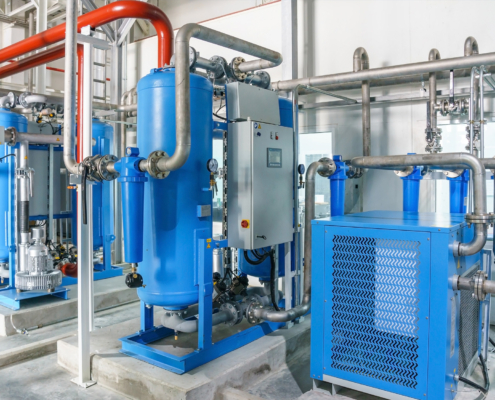 https://pioneerair.com/wp-content/uploads/2024/05/Choosing-Replacement-Desiccant-Air-Dryers-Pitfalls-to-Avoid.jpg
1250
2000
Abstrakt Marketing
/wp-content/uploads/2022/05/pioneer_air_systems_logo.png
Abstrakt Marketing2024-05-09 20:47:392025-06-03 20:28:56Choosing Replacement Desiccant Air Dryers: Pitfalls to Avoid
https://pioneerair.com/wp-content/uploads/2024/05/Choosing-Replacement-Desiccant-Air-Dryers-Pitfalls-to-Avoid.jpg
1250
2000
Abstrakt Marketing
/wp-content/uploads/2022/05/pioneer_air_systems_logo.png
Abstrakt Marketing2024-05-09 20:47:392025-06-03 20:28:56Choosing Replacement Desiccant Air Dryers: Pitfalls to AvoidThe Complete Guide to Compressed Air Systems
Commercial and industrial facilities can immensely benefit from choosing the right compressed air system. In this guide, we will cover what they are, how to identify their typical components, and other some frequently asked questions. We will also examine factors to consider when choosing a compressed air system.
Compressed Air System FAQs
What are compressed air systems
A compressed air system is a network of components and equipment that generates, stores, and distributes compressed air. Typically, a compressor directs air to a higher pressure into tanks for storage. From there, a distribution system can release it to power pneumatic devices and machinery.
What are the typical components of a compressed air system
Typical components of a compressed air system include an air compressor, receiver tank, air dryer or filter, pressure regulator, various valves and fittings, distribution piping, and end-use devices.
What are the advantages of using a compressed air system in commercial and industrial applications
These systems are versatile, easy to use, and are also often safer than electrical systems in certain hazardous environments. Also, compressed air can be stored for later use to better meet peak demands.
What are the common compression methods
The most common systems are reciprocating compressors, rotary screw compressors, and centrifugal compressors, each with its own advantages for different applications and air demand levels.
How do I properly maintain and service a compressed air system to ensure optimal performance and efficiency
To ensure a compressed air system works efficiently, maintenance should cover checking for air leaks, changing filters, inspecting belts and hoses, monitoring oil levels, and keeping the system clean. Following the manufacturer’s guidelines and scheduling routine service checks are critical.
What are some common issues or problems that can arise in compressed air systems, and how can they be resolved
Common issues in compressed air systems include air leaks, inadequate pressure, excessive moisture, and oil contamination. Air leaks can be resolved with proper identification and repair. Insufficient pressure might require upgrading the compressor or adjusting pressure regulators. Air dryers and proper filtration systems can mitigate moisture and oil contamination.
Can a compressed air system be used for more than just powering pneumatic tools
Compressed air systems can support various applications beyond pneumatic tools, such as spray painting, air agitation, material handling, cleaning, aeration in wastewater treatment, and medical equipment.
Are there any safety considerations associated with compressed air systems, and what precautions should be taken
Compressed air systems require specific precautions to ensure safety: wearing appropriate personal protective equipment; using safety devices such as pressure relief valves; properly securing and anchoring equipment; avoiding direct contact with compressed air; following proper lockout or tagout procedures during maintenance.
How can I estimate the energy costs of running a compressed air system, and what are some strategies for improving its energy efficiency
To estimate energy costs, monitor the compressor’s power consumption and multiply it by the electricity rate. You can maintain efficiency by regularly checking and adjusting pressure settings to match actual demands, fixing leaks, insulating pipes to reduce heat loss, and using energy-efficient compressors. Also, you should consider implementing an energy management system to optimize the system’s overall efficiency, with regular audits to identify specific areas for improvement.
Are compressed air systems and breathing air systems the same
Differentiating between the two is crucial, as they serve distinct purposes and have varying safety requirements. Instead of supporting industrial applications, a breathing air system provides clean and breathable air for respiratory protection. This is typically for environments where air quality is a concern, such confined spaces or hazardous locations. Breathing air systems undergo more stringent filtration and testing to ensure compliance with health and safety standards, making them suitable for life support.
How to Identify What Compressed Air Systems Are Needed for Your Facility
- Assess air demands: Analyze required air pressure and flow rates.
- Understand applications: Identify specific tasks and equipment using compressed air.
- Consider future growth: Account for potential expansion or increased air demands.
- Evaluate space and installation: Determine available space and ease of installation.
- Analyze energy efficiency: Compare the energy consumption of different compressor types.
- Budget constraints: Consider upfront costs, maintenance expenses, and long-term savings.
- Review noise levels: Assess noise regulations and choose quieter systems if needed.
- Explore filtration and dry air needs: Identify air quality requirements for applications.
- Safety considerations: Ensure compliance with safety standards for air systems.
- Seek expert advice: Consult with compressed air specialists or manufacturers, like Pioneer, for tailored recommendations.
While our team is equipped with the highest quality air systems at Pioneer, that’s not all we offer. Learn more about how our complete line of air and gas accessories can assist your facility.
Partner With Pioneer Air Systems for Industry-Leading Compressed Air Systems
Experience unmatched performance and reliability with Pioneer’s industry-leading compressed air systems. Increase productivity, minimize downtime, and ensure optimal efficiency for your business. Reach out to our team of experts for top-notch solutions that deliver exceptional results today.





